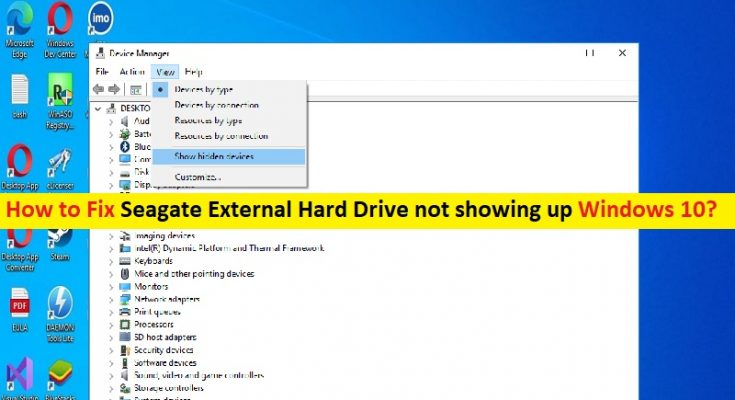Tips to Fix Seagate External Hard Drive not showing up Windows 10:
In this article, we are going to discuss on How to fix Seagate External Hard Drive not showing up Windows 10. You will be guided with easy steps/methods to resolve the issue. Let’s starts the discussion.
‘Seagate External Hard Drive not showing up’ issue in Windows 10: It is common Windows Problem considered as Seagate External Hard Drive issue. This issue indicates you are unable to access Seagate External Hard Drive in your Windows 10 computer and experience Seagate External Hard Drive is not detected/recognised in Windows computer for some reasons. In Device Manager, it gets detected and in disk management, it shows up as unallocated.
There could be several reasons behind the issue including poor Seagate External Hard Drive connection, outdated/corrupted Seagate External Hard Driver, issue with partition of Seagate External Hard Drive, incorrect system settings relating to Seagate External Hard Drive, and other issues. You should make sure Seagate External Hard Driver is properly installed and is up-to-date in computer and if not, Seagate External Hard Driver update is necessary if you don’t want this type of issue.
Some common Seagate External Hard Drive issues:
- Seagate hard drive quit working
- Seagate hard drive won’t turn on, show up, work, mount
- Seagate hard drive Error code 43
- Seagate hard drive you can only read
- Seagate hard drive undetectable, unable to read
- Seagate hard drive Access denied
- Seagate hard drive keeps disconnecting, beeping, freezing, blinking, ejecting, disappearing, clicking, shutting down
How to Fix Seagate External Hard Drive not showing up Windows 10?
Method 1: Fix Seagate External Hard Drive not showing up with ‘PC Repair Tool’
‘PC Repair Tool’ is easy & quick way to find and fix BSOD errors, DLL errors, EXE errors, problems with programs/applications, malware or viruses infections in computer, system files or registry issues, and other system issues with just few clicks.
Method 2: Remove Seagate programs from computer and reinstall them

Step 1: Open ‘Settings’ App in Windows PC via Windows Search Box and go to ‘Apps > Apps & Features’
Step 2: Find and select ‘Seagate Software’, and click ‘Uninstall’ to uninstall it and after that, restart your computer
Step 3: After restart, open your browser and visit Seagate’s website official, download Seagate software from there and install it again in your computer.
Method 3: Download or reinstall Seagate External Hard Disk driver update in Windows PC [Automatically]
You can also try to update all Windows drivers including Seagate External Hard Disk driver update using Automatic Driver Update Tool. You can get this tool through link/button below.
Method 4: Disable Microsoft OneDrive
This issue can be occurred due to interference of OneDrive app in computer. You can disable OneDrive app in order to fix.
Step 1: Press ‘CTRL + SHIFT + ESC’ keys on keyboard to open ‘Task Manager’ app
Step 2: Click ‘Startup’ tab, find and right-click on ‘Startup’ tab and select ‘Disable’ to disable it
Step 3: Once you disable OneDrive, check if the issue is resolved.
Method 4: Remove Paragon driver software and reinstall it
Step 1: Find ‘Paragon Driver’ setup file, right-click on it and select ‘Properties’
Step 2: Click ‘Compatibility’ tab, check ‘Run this program in compatibility mode for’, and select the older version of Windows, and then hit ‘Apply > Ok’ button to save the changes and check if the issue is resolved.
Method 5: Disable Fast Startup

Step 1: Open ‘Control Panel’ app in Windows PC and go to ‘Hardware and Sound > Power Options > Choose what the power button does > Change settings that are currently unavailable’
Step 2: Scroll down to ‘Shutdown Settings’ section, uncheck ‘Turn OFF Fast Startup (Recommended)’ and click ‘Save Changes’. Once done, check if the issue is resolved.
Method 6: Plug your Seagate External Hard Drive to a different USB port
This issue can be occurred due to bad Seagate External Hard Drive connection. You can disconnect Seagate External Hard Drive from computer and reconnect it to a different USB port of computer, and check if it works for you.
Method 7: Switch to Local Account in Windows PC
Step 1: Open ‘Settings’ App in Windows PC and go to ‘Accounts > Your Accounts > Sign-in with a local account instead’
Step 2: Enter your Microsoft Account password and hit ‘Next’
Step 3: Enter a new username and password that you want to use, and click ‘Sign out and finish’. Login back to your local account, and check if the issue is resolved.
Method 8: Disable your third-party antivirus/firewall
This issue can be occurred due to interference of third-party antivirus/firewall program installed in computer. You can disable your third-party antivirus/firewall program in computer in order to fix.
Method 9: Make sure you partition the hard drive

Step 1: Open ‘Computer Management’ app in Windows PC via Windows Search Box
Step 2: Find and click ‘Disk Management’, find your Seagate External Hard Drive, right-click on it, and select ‘Delete Volume’.
Step 3: Now, you should see ‘Disk1’ available, right-click on it and select ‘Convert to GPT’, right-click on it again, and choose ‘New Simple Volume’. Once done, check if the issue is resolved.
Method 10: Make sure the Seagate GoFlex has assigned drive letter
Step 1: Open ‘Computer Management’ and go to ‘Disk Management’
Step 2: In Disk Management, you should see a drive without a letter. Check its size and make sure that this drive is your Seagate GoFlex drive
Step 3: Right-click it, and choose ‘Change Drive Letter’. If this drive doesn’t have assigned letter, add it. Save the changes, and check if the issue is resolved.
Conclusion
I am sure this post helped you on How to fix Seagate External Hard Drive not showing up Windows 10 with easy ways. You can read & follow our instructions to do so. That’s all. For any suggestions or queries, please write on comment box below.



